The Spanish colonizers in the Philippines extensively exploited the country’s abundant natural resources for their economic gain. During the period of Spanish colonization, the Philippines was seen as a strategic location for the spice trade and as a base for spreading Christianity to neighboring countries. The Spanish established a permanent settlement in Manila and implemented a system of indirect rule, which created an upper class known as the principalía.
- The Spanish targeted the Philippines for its potential in the spice trade and proximity to China and Japan.
- They established a system of indirect rule and created an upper class referred to as the principalía.
- Private land ownership was introduced, leading to the concentration of land in the hands of a few.
- Colonial income mainly came from the Manila Galleon Trade, which brought silver in exchange for Chinese goods.
- The Spanish co-opted the traditional Filipino elite into the colonial government, reinforcing their social, economic, and political dominance.
Motivations Behind the Spanish Colonizers’ Exploitation
The Spanish colonizers were primarily driven by the lucrative spice trade, the strategic proximity to China and Japan, and their mission to convert Filipinos to Christianity. The Philippines’ abundant natural resources, including spices such as cinnamon, cloves, and nutmeg, attracted Spanish interest as they sought to control the profitable spice trade in the region.

The Spanish saw the Philippines as an ideal base for their missionary efforts in Asia, as it provided a convenient location for their interactions with China and Japan. The Spanish aimed to spread Catholicism and establish a Christian stronghold in the region, using the conversion of Filipinos as a means to achieve their religious goals.
The desire for economic gains and religious objectives were closely intertwined, as the Spanish believed that controlling the trade routes and resources of the Philippines would help fund their missionary endeavors. By exploiting the natural resources of the archipelago, the Spanish hoped to enrich themselves and support their religious mission.
The Manila Galleon Trade
“The Spanish saw the Philippines as a gateway to the wealth of the East, connecting the Americas, Europe, and Asia through the Manila Galleon Trade” – Spanish historian Juan de Silva
The Spanish established the Manila Galleon Trade, a maritime route that connected Manila with Acapulco in Mexico. This trade route facilitated the exchange of goods between Asia and the Americas, with the Philippines serving as a crucial link. The Spanish traded silver from Mexico for Chinese goods, creating a profitable enterprise that contributed to the colonial income of the Philippines.
Throughout their colonization, the Spanish co-opted the traditional Filipino elite into the colonial government, cementing their control and ensuring the cooperation of the local ruling class. This collaboration further perpetuated social, economic, and political dominance, reinforcing the exploitative nature of Spanish rule in the Philippines.
| Spanish Colonizers’ Exploitation | Date |
|---|---|
| Establishment of Spanish rule in the Philippines | 1565 |
| Introduction of private land ownership | 1849 |
| Manila Galleon Trade | 1565-1815 |
| Continued foreign mining and government regulations | 1900-present |
Establishment of Spanish Rule and the Principalía
The Spanish colonizers established a permanent settlement in Manila and introduced a system of indirect rule, which included the development of an influential upper class known as the principalía. This ruling class consisted of Filipinos who aligned themselves with the Spanish colonizers and were granted privileges and authority in exchange for their loyalty. The principalía played a significant role in the Spanish colonial system, acting as intermediaries between the Spanish authorities and the local population.
The Spanish implemented this system of indirect rule to maintain control while minimizing direct involvement. By co-opting the traditional Filipino elite into positions of power, the Spanish colonizers ensured the stability of their rule and created a sense of collaboration with the local population. Through their cooperation with the Spanish, the principalía gained social status, economic opportunities, and access to resources.
This image depicts a scene from the Spanish colonial era in the Philippines, with members of the principalía engaging in a discussion with Spanish officials. The image showcases the interaction between the Spanish colonizers and the local elite, highlighting the dynamics of power and influence during that time.
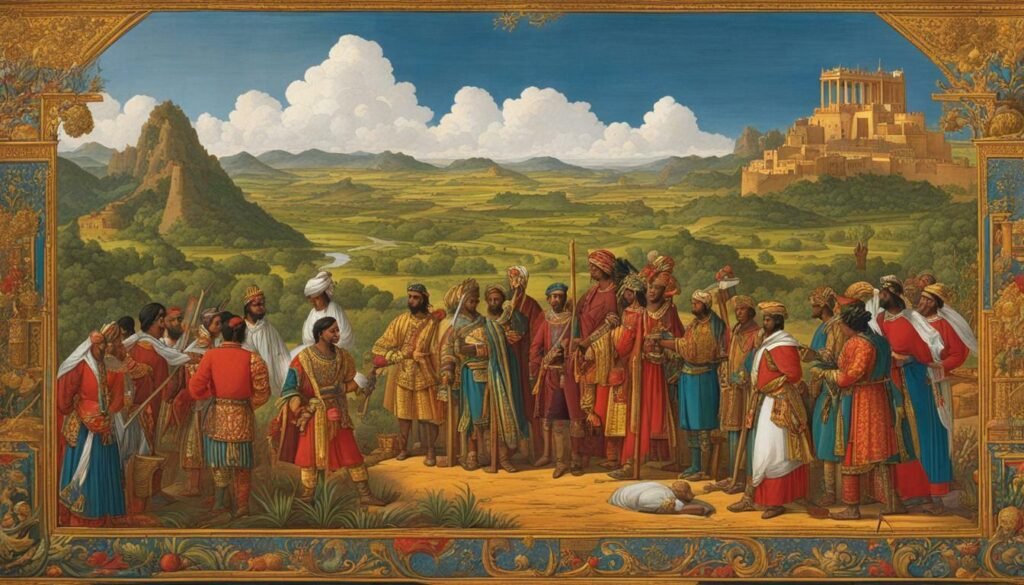
While the establishment of the principalía served the Spanish colonizers’ interests, it contributed to the perpetuation of social and economic inequality within Filipino society. The concentration of power and resources in the hands of the principalía further marginalized the majority of the population, deepening existing divisions and hierarchies. This system of indirect rule, coupled with the Spanish introduction of private land ownership, set the stage for long-term socioeconomic disparities that continue to impact the Philippines today.
Timeline of Foreign Mining and Government Regulations
| Year | Event |
|---|---|
| 1521 | Ferdinand Magellan’s arrival in the Philippines |
| 1565 | Establishment of the Spanish settlement in Manila |
| 1571 | Foundation of the City of Manila |
| 1647 | Chinese uprising in the Philippines |
This table provides a brief timeline of significant events related to foreign mining and government regulations in the Philippines. It showcases key historical moments that shaped the exploitation of the country’s natural resources throughout the Spanish colonial period and beyond.
Impact of Private Land Ownership
The Spanish implementation of private land ownership replaced the traditional communal land-use system, resulting in the concentration of land ownership among a privileged minority. Under this new system, large tracts of land were granted to Spanish colonizers and Filipino elites, while indigenous communities were displaced from their ancestral territories. This shift led to the dispossession of indigenous peoples from their traditional lands and a loss of communal control over resources.
This transition to private land ownership had profound socio-economic implications for the Philippines. The privileged few who acquired extensive land holdings used their power and wealth to exploit the country’s natural resources for their own benefit. Logging, mining, and large-scale agricultural activities, such as sugar and tobacco plantations, became dominant industries, contributing to the export-oriented economy established by the Spanish colonizers.
The effects of private land ownership were felt beyond the economic realm. The concentration of land in the hands of a few exacerbated social inequality, creating a vast divide between the wealthy landlords and the impoverished majority. The dispossessed indigenous communities and landless farmers became dependent on the landowners for employment and sustenance, perpetuating a cycle of exploitation and poverty.
Table: Impact of Private Land Ownership
Here is a table summarizing the impact of private land ownership in the Philippines during Spanish colonization:
| Impact | Description |
|---|---|
| Wealth Concentration | Ownership of large tracts of land consolidated in the hands of Spanish colonizers and Filipino elites, leading to economic dominance and social inequality. |
| Resource Exploitation | Landowners exploited natural resources, such as timber, minerals, and agricultural produce, for export-oriented industries. |
| Displacement | Indigenous communities and landless farmers were displaced from their ancestral lands, leading to loss of culture, livelihoods, and identity. |
| Economic Dependence | Dispossessed communities became dependent on landowners for employment, perpetuating a cycle of exploitation and poverty. |
The impact of private land ownership during Spanish colonization left a lasting legacy on the socio-economic landscape of the Philippines. It created deep-rooted inequalities that continue to persist today, highlighting the need for land reform initiatives and sustainable practices to address the historical injustices and promote a more equitable society.
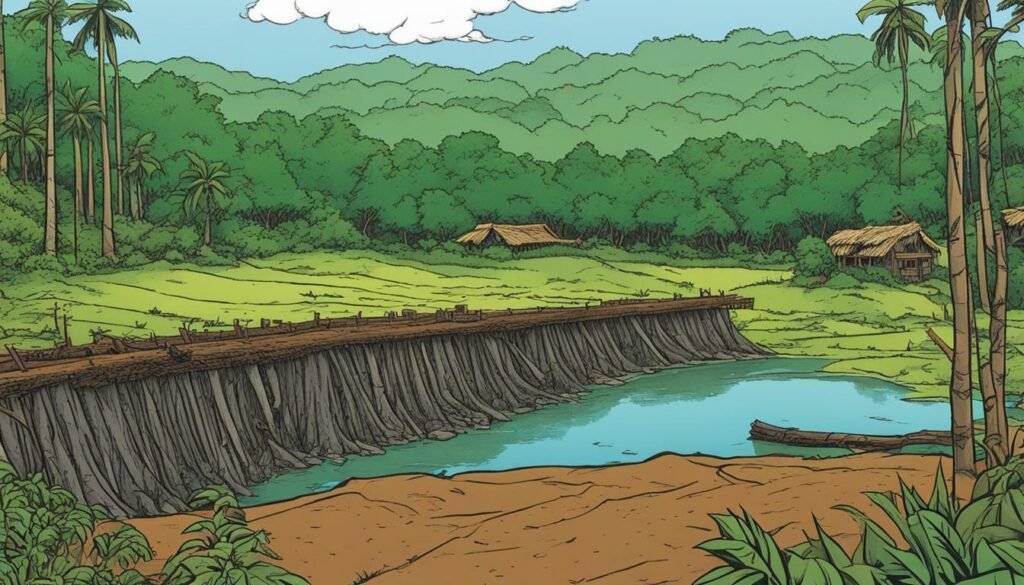
The Spanish derived a significant portion of their colonial income from the Manila Galleon Trade, a trade route that exchanged Mexican silver for valuable Chinese goods. This trade route, established in the 16th century, connected the Philippines, Mexico, and China, enabling the Spanish to benefit from the exchange of these lucrative commodities.
The Manila Galleon Trade played a crucial role in the Spanish economy, as it allowed for the accumulation of silver from the mines of Mexico, particularly from the regions of Zacatecas and Guanajuato. This silver was then transported across the Pacific Ocean to Manila, where it was exchanged for Chinese goods such as silk, porcelain, and spices.
“The Manila Galleon Trade symbolized the economic and cultural exchange between the East and the West. It was a highly profitable enterprise for the Spanish, as they had a monopoly on this trade route.”
- The silver obtained from the Manila Galleon Trade was not only used to finance the Spanish empire but also played a significant role in facilitating trade with China and other Asian countries.
- This trade route allowed the Spanish to satisfy the high demand for Chinese goods in Europe, thus generating substantial profits.
- Additionally, the Manila Galleon Trade brought about cultural exchange between Asia and Europe, as the Philippines became a hub for the exchange of ideas, art, and technology.
Overall, the Manila Galleon Trade was a vital source of colonial income for the Spanish, enabling them to maintain their rule in the Philippines and fund their expanding empire. It symbolized the economic and cultural exchange between the East and the West, shaping the history and economy of the Philippines during the colonial period.

| Key Points | Details |
|---|---|
| The Manila Galleon Trade | A trade route connecting the Philippines, Mexico, and China |
| Sources of Colonial Income | Exchange of Mexican silver for Chinese goods |
| Profitability | The Spanish had a monopoly on this trade route |
| Impact | Significant economic and cultural exchange between Asia and Europe |
Co-opting of the Filipino Elite
The Spanish colonizers strategically integrated the Filipino elite into the colonial government, further reinforcing their control over the Philippines. This co-optation allowed the Spanish to maintain their dominance by capitalizing on the existing social hierarchy and power structures. By incorporating the Filipino elite into the colonial system, the Spanish were able to exert influence over local affairs while also benefiting from the support and loyalty of this privileged class.
The assimilation of the Filipino elite into the colonial government can be seen as a tactic aimed at quelling potential opposition and fostering collaboration. By offering positions of power, wealth, and social status to the ruling class, the Spanish created incentives for loyalty and compliance. The Filipino elite, in turn, gained access to opportunities for political influence and economic advancement within the colonial framework.
This integration of the Filipino elite into the colonial government had profound and lasting effects on Philippine society. The Spanish effectively co-opted the traditional power structures and institutions, consolidating their rule and exploiting existing divisions among the local population. As a result, social and economic inequality was perpetuated, with power and wealth concentrated in the hands of the Spanish and their Filipino collaborators.
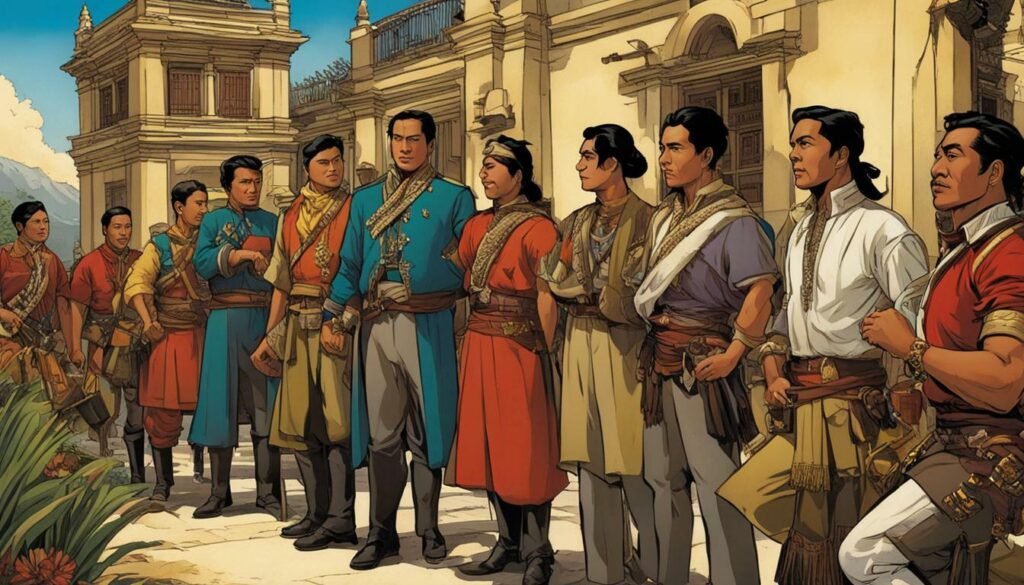
“The integration of the Filipino elite into the colonial government allowed the Spanish to maintain control and reinforce their dominance over the Philippines.”
Despite the Spanish colonizers’ efforts to co-opt the Filipino elite, discontent and resistance among the local population continued to simmer beneath the surface. The exploitative nature of the colonial system, coupled with the denial of basic rights and freedoms, fueled a growing desire for independence and self-determination.
This section sheds light on the Spanish colonizers’ strategic maneuver to integrate the Filipino elite into the colonial government, which played a pivotal role in maintaining their control over the Philippines. The next section will touch upon the continuation of exploitative practices during the American colonization and the ongoing challenges faced by the country in regards to the sustainability of its natural resources.
American Continuation of Exploitative Practices
The American colonizers continued the exploitative practices established by the Spanish in the Philippines during their period of colonization. Building upon the systems set in place by their predecessors, the Americans further exploited the country’s natural resources for their economic gain. This continued exploitation had significant social, economic, and environmental consequences that have shaped the Philippines to this day.
One of the key areas where American colonization continued exploitative practices was in the extraction of minerals. Foreign miners were given access to the Philippines’ rich mineral deposits, leading to extensive mining operations. This extraction of minerals often disregarded environmental regulations and caused significant damage to the country’s ecosystems.
“The exploitation of the Philippines’ natural resources by the Americans was driven by a desire for profit and economic dominance. The focus was on extracting as much wealth as possible, without considering the long-term consequences for the Filipino people or the environment.”
Additionally, the American colonizers further consolidated their control over the Philippines by co-opting the local elite into positions of power. This allowed them to maintain social and economic dominance, as well as perpetuate exploitative practices. The exploitation of the Philippines’ natural resources continued to benefit the colonizers and their economic interests, while leaving the majority of the Filipino population in poverty.
Image: American Colonization in the Philippines
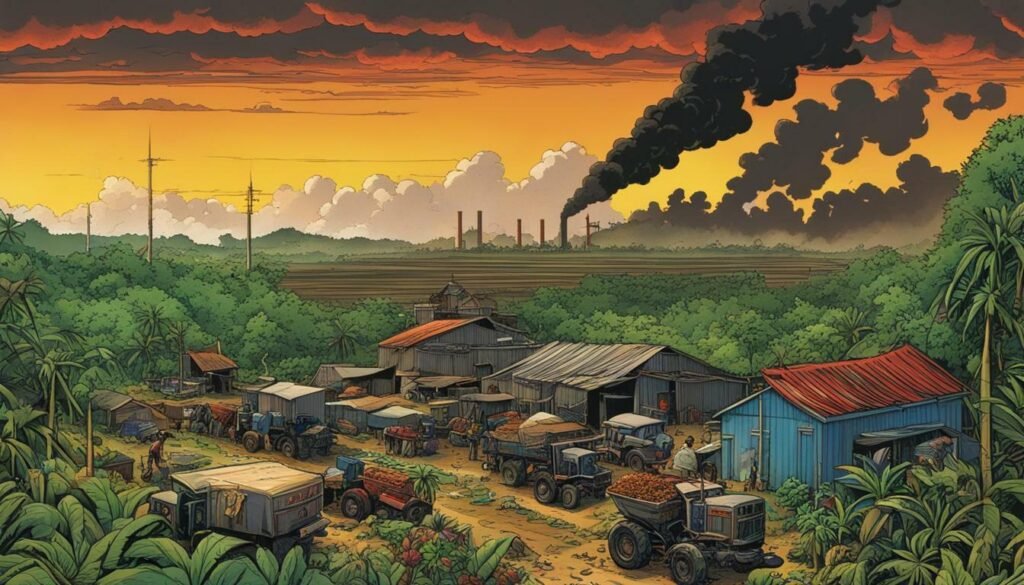
Despite the continuation of exploitative practices, it is important to note that the Philippines also experienced some positive developments during American colonization. The American government introduced reforms in education, public health, and infrastructure, which laid the foundation for future progress. However, these advancements were often overshadowed by the ongoing exploitation of the country’s resources.
In conclusion, the American colonizers continued the exploitative practices established by the Spanish in the Philippines during their period of colonization. Through the extraction of minerals, co-optation of local elites, and disregard for the environment, the Americans furthered the economic, social, and environmental imbalances in the country. Understanding this history is crucial in addressing the challenges faced by the Philippines today and working towards a more sustainable and equitable future.
Timeline of Foreign Mining and Government Regulations
The timeline highlights the ongoing extraction of minerals by foreign mining companies in the Philippines and the government’s efforts to regulate the industry. Since the Spanish colonization period, foreign miners have been attracted to the rich mineral resources of the country, contributing to economic growth but also raising concerns about environmental degradation and the loss of local control over natural resources.
In the late 19th century, American companies began to invest in mining operations in the Philippines, leading to a significant increase in mineral extraction. The influx of foreign miners prompted the Philippine government to establish regulations to govern the industry. In 1900, the Mining Act was enacted to provide guidelines for the exploration, development, and utilization of mineral resources.
Throughout the 20th century, the mining industry in the Philippines experienced fluctuations due to geopolitical events and economic factors. In the 1970s, the government implemented a policy of nationalization, aiming to increase local ownership and control over the mining sector. However, this policy was later reversed in the 1990s, as the government recognized the importance of foreign investments for the development of the industry.
Currently, the Philippine government continues to refine its regulations to strike a balance between economic development and environmental sustainability. Efforts have been made to improve transparency and accountability in the mining sector, promoting responsible mining practices and ensuring the protection of local communities and the environment. However, challenges remain, including illegal mining activities and conflicts over land rights.

| Year | Event |
|---|---|
| 1900 | Enactment of the Mining Act to regulate the industry |
| 1970s | Implementation of a nationalization policy |
| 1990s | Reversal of the nationalization policy to attract foreign investments |
| Present | Continued efforts to promote responsible mining and protect local communities and the environment |
- Foreign mining companies have been extracting minerals in the Philippines since the Spanish colonization period.
- The government enacted the Mining Act in 1900 to establish regulations for the industry.
- In the 1970s, a nationalization policy was implemented to increase local ownership and control.
- In the 1990s, the government reversed the nationalization policy to attract foreign investments.
- The Philippine government is currently striving to balance economic development and environmental sustainability in the mining sector.
“The continuous extraction of minerals by foreign miners in the Philippines has sparked debates about the management and protection of our natural resources. It is crucial for the government to implement stringent regulations to ensure responsible mining practices and safeguard the welfare of local communities.” – Environmental Advocate
Conclusion:
Foreign mining in the Philippines has a complex history, marked by periods of regulation and changes in policy. The timeline highlights the ongoing challenges of balancing economic development with environmental sustainability. It is essential for the government to enforce regulations that prioritize responsible mining practices, protect local communities, and preserve the country’s natural resources for future generations.
Socioeconomic Impact of Exploitation
The exploitation of the Philippines’ natural resources by the Spanish colonizers had deep-rooted socioeconomic impacts that are still felt today. During their rule, the Spanish targeted the Philippines for its strategic location in the spice trade and its proximity to China and Japan for missionary efforts and religious conversion. The establishment of Spanish rule brought significant changes to the social and economic landscape of the archipelago.
One of the key impacts was the introduction of private land ownership, replacing the traditional communal land use practices of indigenous communities. This resulted in the concentration of land in the hands of a few wealthy landowners, leading to widespread landlessness and inequality among the local population. The socioeconomic divide between the wealthy elite and the impoverished majority persists to this day.
The Spanish also co-opted the traditional Filipino elite, known as the principalía, into the colonial government. This further entrenched the social, economic, and political dominance of the Spanish colonizers and their local collaborators. The exploitation of the natural resources, coupled with the oppressive colonial policies, created a system of economic dependency and increased social inequity that continues to shape the socioeconomic landscape of the Philippines.
| Impact | Description |
|---|---|
| Land Concentration | The introduction of private land ownership led to the concentration of land in the hands of a few wealthy landowners, resulting in landlessness and inequality among the local population. |
| Social Inequity | The exploitation of natural resources and the oppressive colonial policies created a system of economic dependency and increased social inequity, perpetuating the socioeconomic divide. |
| Dependency on Elite | The co-optation of the traditional Filipino elite into the colonial government solidified their position of power, deepening the dependency of the majority on the ruling class. |
These socioeconomic impacts have shaped the Philippines’ development trajectory and continue to pose challenges to its progress and sustainability. Efforts are being made to address the historical injustices and promote inclusive growth and sustainable development in the country. However, it is crucial to acknowledge and understand the lasting effects of the Spanish colonizers’ exploitation of the Philippines’ natural resources in order to create a more equitable and sustainable future.
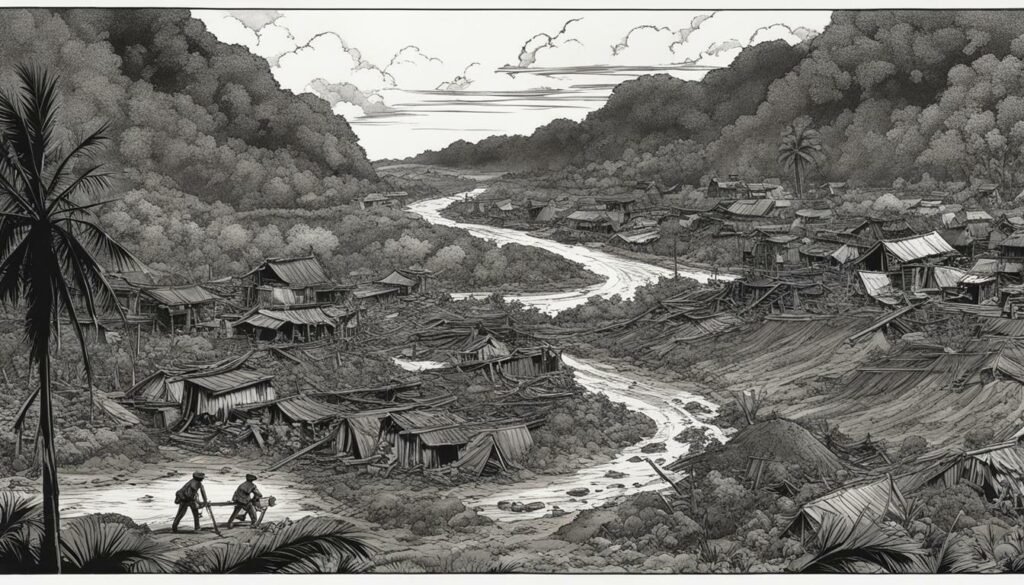
The Spanish colonizers’ exploitation of the Philippines’ natural resources resulted in significant environmental consequences that have had a lasting impact on the country’s ecology. The extraction and extensive logging of timber, particularly the highly prized Philippine Mahogany, led to deforestation on a massive scale. This loss of forest cover not only disrupted local ecosystems but also contributed to soil erosion and the loss of biodiversity. The clear-cutting of forests also had a direct impact on indigenous communities who depended on these resources for their livelihoods.
In addition to deforestation, mining activities during the Spanish colonial period also had severe environmental repercussions. The search for precious metals, such as gold and silver, led to the excavation and alteration of landscapes in various parts of the country. The use of mercury in the extraction process resulted in the release of toxic pollutants into waterways, contaminating rivers and affecting aquatic life. These mining activities left behind scars on the land, with abandoned mine sites still posing environmental hazards to this day.
“The extraction and extensive logging of timber, particularly the highly prized Philippine Mahogany, led to deforestation on a massive scale.”
The Spanish colonizers’ exploitation of the Philippines’ natural resources did not stop at land-based activities. The rich marine resources surrounding the archipelago were also exploited for their economic value. Overfishing and destructive fishing practices, such as dynamite fishing, disrupted marine ecosystems and depleted fish populations. The destruction of coral reefs, crucial marine habitats, further diminished the biodiversity and resilience of the country’s coastal areas.
The environmental consequences of Spanish exploitation have had long-lasting effects on the Philippines’ ecology. Today, efforts are being made to address these issues and promote sustainable practices. Government regulations, conservation initiatives, and community-led projects are working towards restoring damaged ecosystems, protecting threatened species, and preserving the natural heritage of the Philippines for future generations.
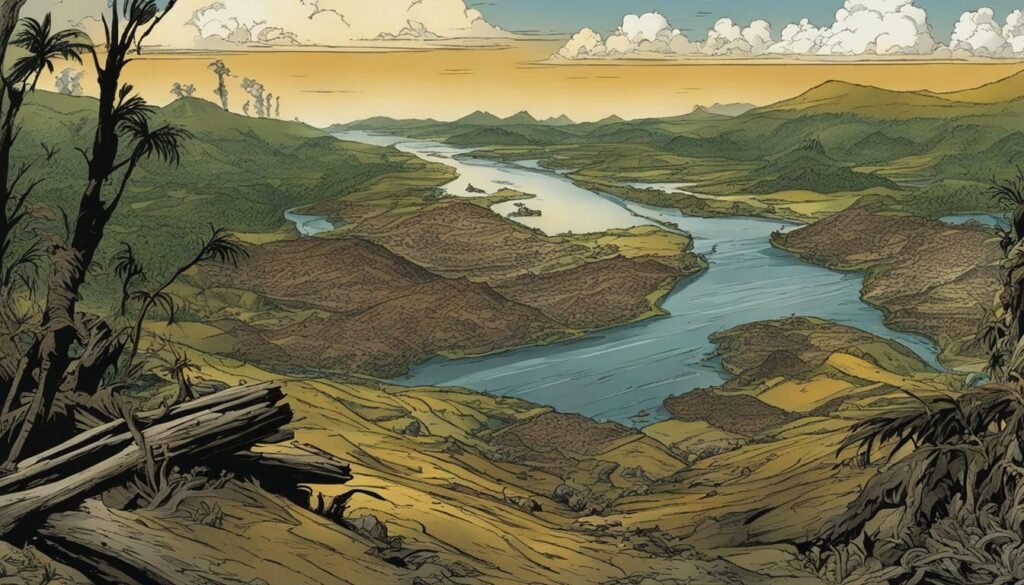
| Environmental Consequences | Solutions and Efforts |
|---|---|
| Massive deforestation | Reforestation programs, protected areas, sustainable logging practices |
| Soil erosion and loss of biodiversity | Soil conservation, reforestation, biodiversity conservation |
| Mercury pollution from mining | Strict regulations, responsible mining practices, mine site rehabilitation |
| Overfishing and destructive fishing practices | Fisheries management, marine protected areas, community-based coastal resource management |
| Destruction of coral reefs | Coral reef conservation, restoration projects, sustainable tourism practices |
Current Challenges and Efforts for Sustainability
The Philippines faces numerous challenges in ensuring the sustainable use of its natural resources, but there are ongoing efforts to promote sustainability and responsible resource management. One of the key challenges is the rampant illegal logging and deforestation, which has had devastating effects on the country’s forests and biodiversity. The loss of forest cover not only threatens the habitat of numerous plant and animal species but also contributes to soil erosion, water pollution, and climate change.
To tackle this issue, the government has implemented stricter regulations and enforcement measures to curb illegal logging activities. Additionally, there are initiatives in place to promote reforestation and the sustainable management of forests. These include community-based forestry programs that empower local communities to protect and manage their forest resources, as well as incentives for sustainable logging practices.
Another major challenge is the unsustainable fishing practices that have led to the depletion of marine resources. Overfishing, destructive fishing methods, and the lack of effective fisheries management have resulted in declining fish stocks and damage to coral reefs and other marine ecosystems. The government, in collaboration with non-governmental organizations and fishing communities, has been working towards promoting sustainable fishing practices, such as the establishment of marine protected areas and the implementation of regulations to limit fishing effort and protect endangered species.
Efforts to Promote Sustainable Tourism
The Philippines is known for its beautiful beaches, diverse marine life, and stunning landscapes, making tourism a significant contributor to the country’s economy. However, the rapid growth of tourism has also brought about negative impacts on the environment, including habitat degradation, pollution, and cultural erosion.
In response to these challenges, there are ongoing efforts to promote sustainable tourism practices. This includes the development and implementation of ecotourism programs that prioritize the preservation of natural and cultural heritage, as well as the promotion of responsible tourism practices among visitors. The government has also been working towards improving waste management systems in popular tourist destinations and raising awareness among tourists about the importance of environmental conservation.
Overall, while the Philippines faces numerous challenges in ensuring the sustainable use of its natural resources, there are encouraging efforts being made to address these issues. By implementing stricter regulations, promoting sustainable practices, and engaging local communities and stakeholders, the country is taking significant steps towards preserving its natural heritage for future generations.

| Challenges | Efforts |
|---|---|
| Illegal logging and deforestation | – Stricter regulations and enforcement measures – Community-based forestry programs – Incentives for sustainable logging practices |
| Unsustainable fishing practices | – Marine protected areas – Regulations to limit fishing effort – Awareness and education campaigns |
| Unsustainable tourism | – Ecotourism programs – Responsible tourism practices – Improved waste management systems |
Conclusion
The Spanish colonizers’ exploitation of the Philippines’ natural resources left a lasting legacy of socioeconomic inequality and environmental degradation, highlighting the need for sustainable practices moving forward.
During the period of Spanish colonization, the Philippines was targeted for its potential in the lucrative spice trade and its strategic geographical proximity to China and Japan for missionary efforts and the spread of Christianity. The Spanish established a permanent settlement in Manila and implemented a system of indirect rule, creating an upper class known as the principalía. This system entrenched social, economic, and political dominance and perpetuated inequality among the Filipino population.
With the introduction of private land ownership, communal land use was replaced, leading to the concentration of land in the hands of a few. However, the Spanish did not find exploitable precious metals or significantly alter the ecology of the islands during their colonization. The main source of colonial income came from the Manila Galleon Trade, an entrepôt trade with Mexico that brought silver in exchange for Chinese goods.
The Spanish also co-opted the traditional Filipino elite into the colonial government, further solidifying their control. This system of co-optation and exploitation continued during American colonization, as the Americans perpetuated many of the practices established by the Spanish. Foreign miners also continued to extract minerals from the Philippines, prompting the government’s repeated attempts to regulate the industry.
Overall, the Spanish colonizers’ exploitation of the Philippines’ natural resources had a profound impact on the country. It resulted in socioeconomic inequality, environmental degradation, and a loss of control over the nation’s resources. It is imperative for the Philippines to prioritize sustainable practices and policies that can help mitigate the effects of historical exploitation and ensure the preservation of its natural resources for future generations.
FAQ
Q: What were the motivations behind the Spanish colonizers’ exploitation of the Philippines?
A: The Spanish colonizers targeted the Philippines for its potential in the spice trade, its geographical proximity to China and Japan for missionary efforts, and the conversion of Filipinos to Christianity.
Q: How did the Spanish colonizers establish their rule in the Philippines?
A: The Spanish established a permanent settlement in Manila and implemented a system of indirect rule, creating an upper class referred to as the principalía.
Q: What impact did private land ownership have on the Philippines?
A: The Spanish introduced private land ownership, replacing communal land use, which led to the concentration of land in the hands of a few.
Q: Where did the colonial income of the Spanish in the Philippines come from?
A: Colonial income mainly came from entrepôt trade with Mexico, known as the Manila Galleon Trade, which brought silver in exchange for Chinese goods.
Q: How did the Spanish colonizers maintain their dominance?
A: The Spanish co-opted the traditional Filipino elite into the colonial government, further entrenching their social, economic, and political dominance.
Q: Did American colonization continue the exploitative practices of the Spanish?
A: Yes, the American colonization of the Philippines continued the exploitative practices established by the Spanish.
Q: What were the environmental consequences of the Spanish exploitation?
A: The Spanish did not significantly alter the ecology of the islands but their exploitation did have long-lasting environmental consequences on the Philippines.
Q: Has the government regulated foreign mining in the Philippines?
A: The government has repeatedly attempted to regulate foreign mining through various regulations, as shown in the timeline provided.
Q: What were the socioeconomic impacts of the Spanish exploitation?
A: The Spanish exploitation of the Philippines’ natural resources created social and economic inequality, as well as lasting socioeconomic impacts on the country.
Q: What are the current challenges and efforts for sustainability in the Philippines?
A: The Philippines faces current challenges regarding the sustainability of its natural resources, but there are ongoing efforts to promote sustainable practices.


